Key takeaways:
- Conceptual photography focuses on conveying ideas and emotions rather than just aesthetics, inviting diverse interpretations from viewers.
- It encourages deep discussions and creative exploration, with photographs often sparking critical conversations about societal values.
- Effective techniques such as the rule of thirds, leading lines, and negative space enhance the storytelling aspect of conceptual photography.
- Patience, collaboration, and embracing failure are crucial lessons learned in the creative process, leading to personal growth and deeper understanding.
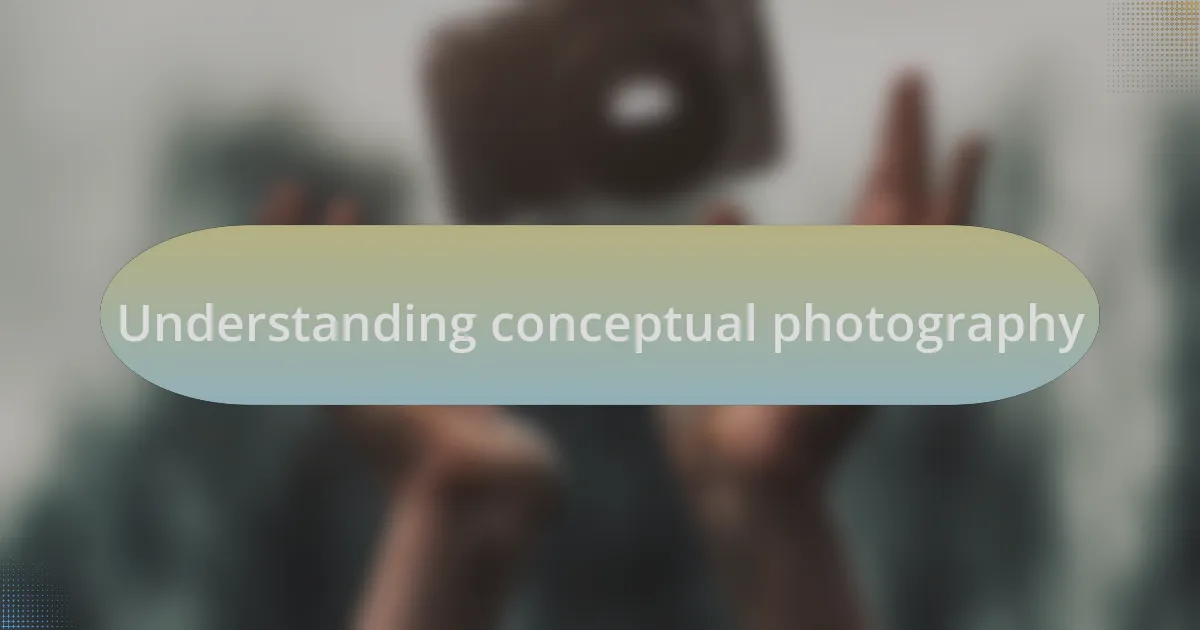
Understanding conceptual photography
Conceptual photography is not just about taking a picture; it’s about conveying an idea or a message. I remember the first time I created an image that spoke not just to aesthetics but to a deeper narrative. It was exhilarating to watch viewers interpret my work differently, each finding their own meaning hidden in the layers of the shot.
At its core, conceptual photography challenges the norm and invites the viewer to think critically. Have you ever looked at an image and wondered what was going through the photographer’s mind? For me, it’s that intersection of emotion and intellect that truly brings a photograph to life. I often find myself contemplating why I chose certain elements and how they all contribute to the overall idea I intended to express.
The beauty of conceptual photography lies in its subjectivity. I once captured a dark, stormy sky paired with an empty swing set, aiming to evoke a sense of nostalgia and loss. It was fascinating to hear others share their interpretations—some saw childhood memories, while others sensed impending change. Isn’t it remarkable how a single image can resonate differently with such a diverse audience?
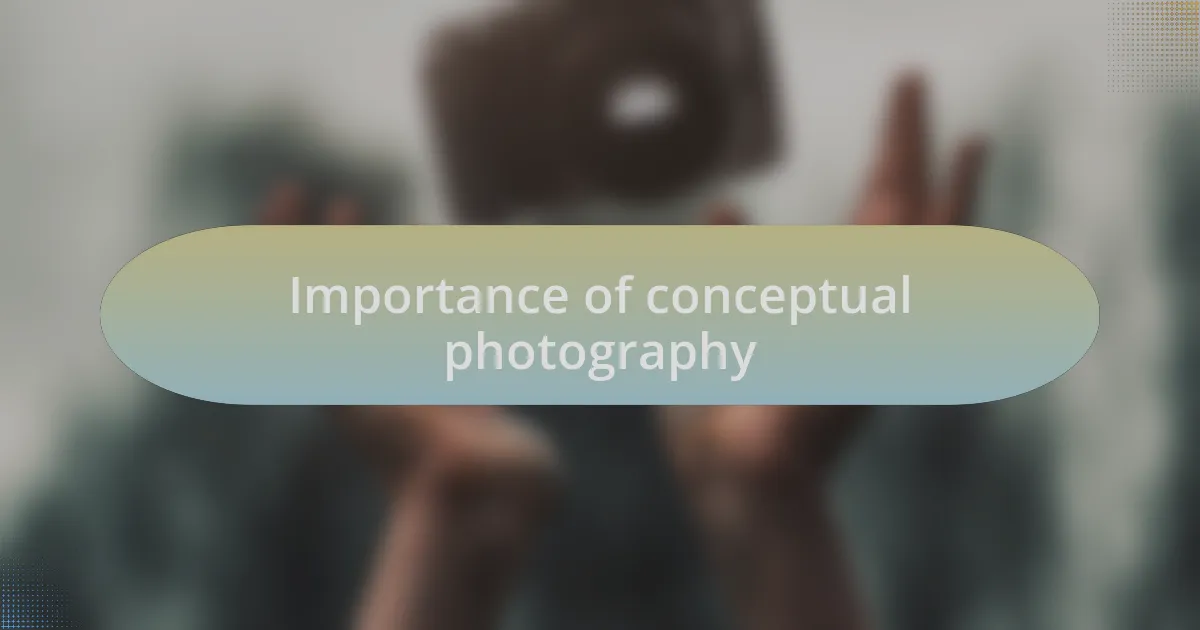
Importance of conceptual photography
Conceptual photography is vital because it allows us to explore complex emotions and ideas through visual storytelling. I remember a project focused on isolation, where I paired a solitary figure with expansive landscapes. It felt powerful to convey loneliness in a way that words often fail to do, revealing to me how images can evoke deep emotional responses.
In my experience, the importance of conceptual photography lies also in its ability to provoke discussion. I created a series that juxtaposed consumerism against nature. The conversations that arose from sharing these images sparked reflections on our societal values and the choices we make. Isn’t it fascinating how a single photograph can inspire such critical dialogue?
Moreover, conceptual photography encourages creativity beyond traditional techniques. I once experimented with shadows and light to symbolize contrasting emotions. It was enlightening to see how different lighting choices influenced the mood of the image, leading me to understand that every decision in the creative process holds significance. This intrinsic relationship between intention and execution is what elevates conceptual photography to a higher form of art.
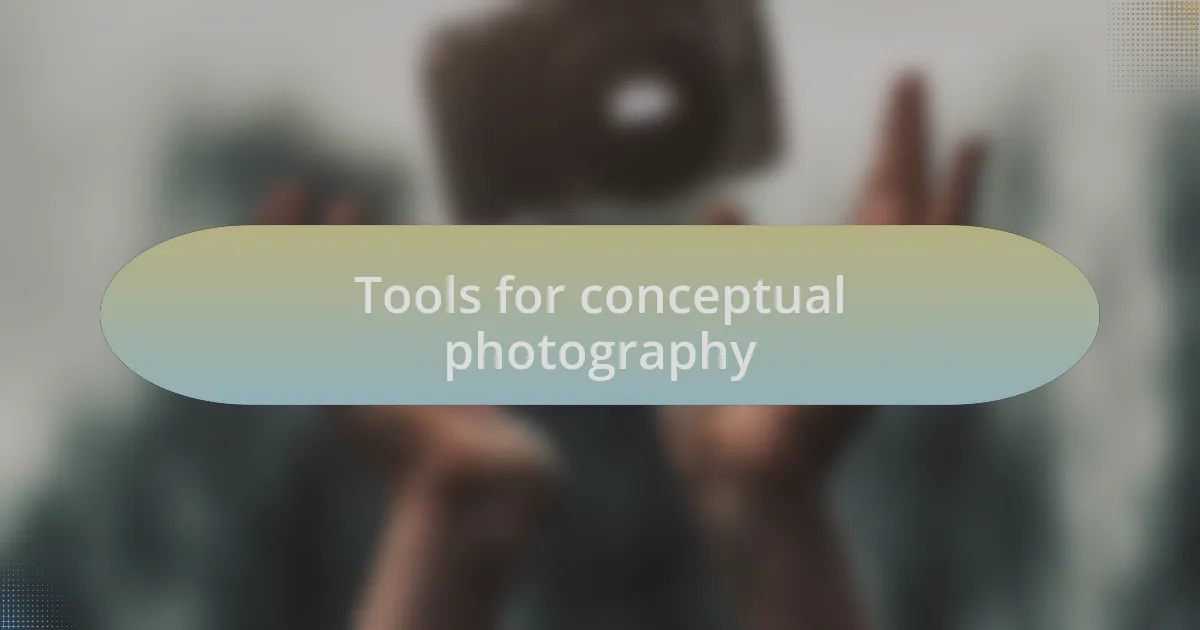
Tools for conceptual photography
When it comes to tools for conceptual photography, the choice of camera can greatly influence your storytelling. For instance, I often use my DSLR for its versatility in different lighting conditions, but there are times when I opt for my smartphone for its immediacy and ability to capture spontaneous moments. Doesn’t it feel liberating to know that creativity can thrive regardless of the gear you use?
In addition to cameras, I find that props can play a pivotal role in enhancing the narrative of a photograph. During a project about nostalgia, I used vintage items like old books and framed photographs to evoke memories. As I arranged the scene, I felt a connection to the past, which drove the emotion home. How fascinating it is that a simple object can hold such weight in conveying a deeper message!
Post-processing tools are also crucial in conceptual photography. I rely on editing software like Photoshop to not just enhance images but to transform them entirely, reflecting my vision. In one instance, I altered colors and added textures to create a dreamlike quality that spoke to the themes of memory and time. Isn’t it incredible how much a digital brush can change the mood of an image?
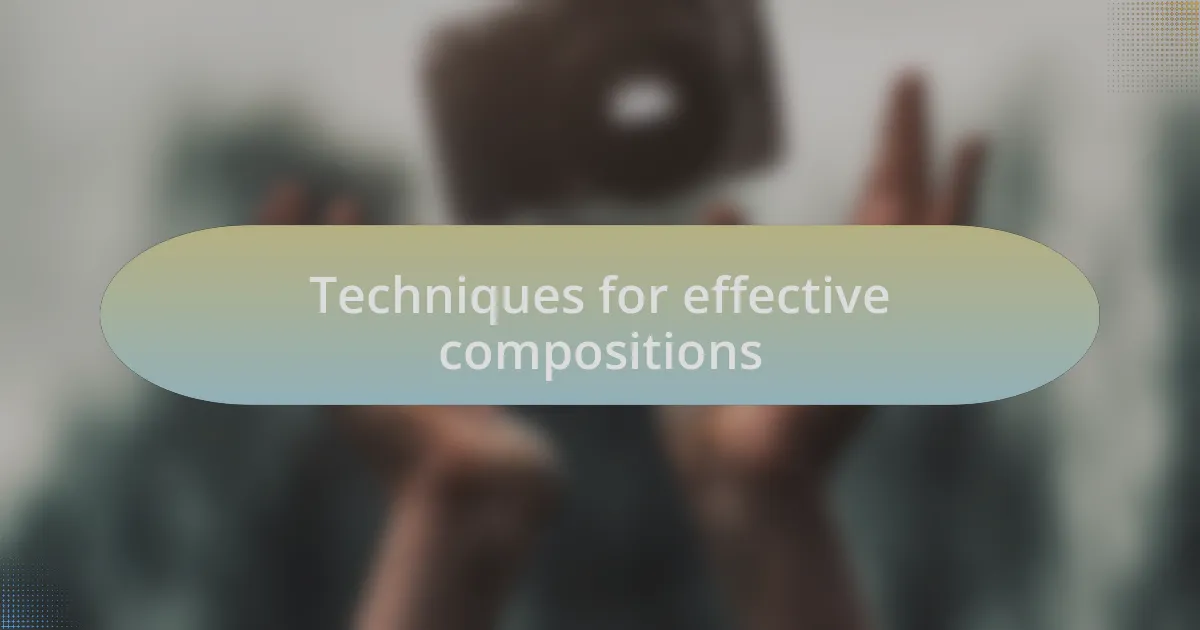
Techniques for effective compositions
When I think about effective compositions, one technique that often comes to mind is the rule of thirds. Instead of simply centering my subject, I intentionally position it off-center, which creates a sense of balance and draws the viewer’s eye. I’ve noticed that this method can transform an ordinary shot into something truly captivating—don’t you agree that subtle shifts in composition can lead to more dynamic visuals?
Another strategy I embrace is leading lines, which guide the viewer’s gaze through the photograph. During a recent shoot in an abandoned warehouse, I utilized the lines of the flooring and the beams overhead to lead the eye toward a single, poignant figure in the distance. This technique not only added depth to the image but also emphasized the isolation of the subject. Isn’t it fascinating how a simple line can tell a story of its own?
Finally, I’ve found that negative space is a powerful tool in conceptual photography. By allowing for plenty of empty space around my subject, I create a sense of openness that invites contemplation. For example, in capturing a lone tree on a hill, I left vast expanses of sky surrounding it, which heightened the tree’s solitude. This approach often prompts viewers to reflect on what they see—or perhaps, what isn’t there. Doesn’t that spark a more profound connection with the image?
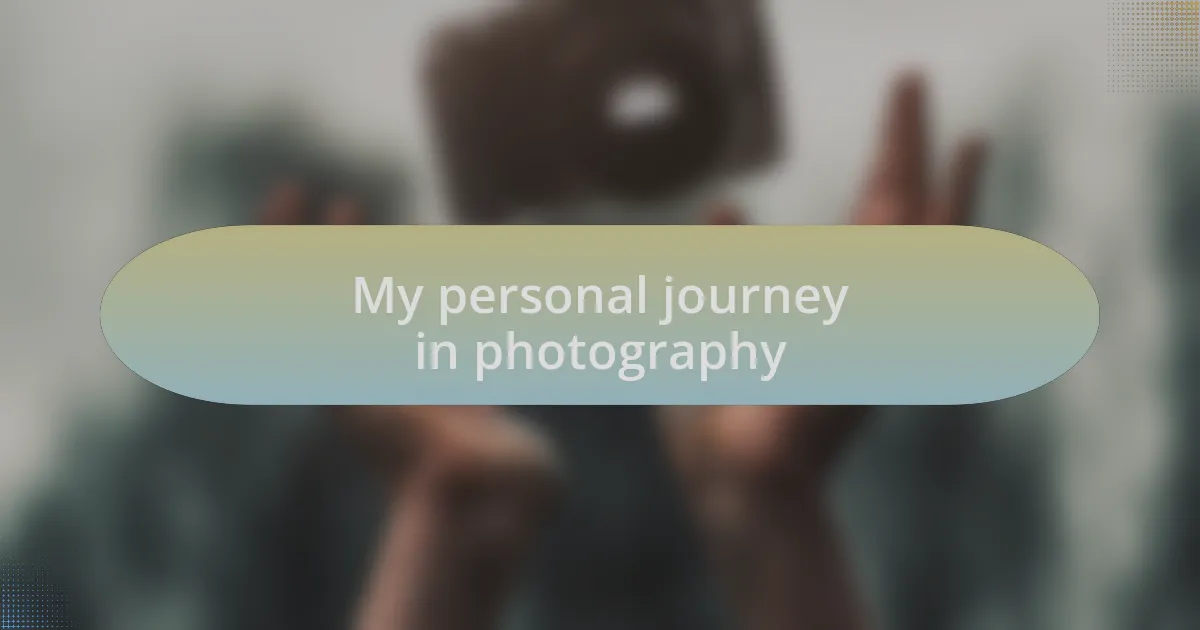
My personal journey in photography
Photography has been my gateway to self-discovery, shaping my perspectives and emotions. I still remember the first time I picked up a camera; I felt an excitement that blended curiosity with a hint of fear. Not knowing what I would capture, I wandered through my neighborhood, fascinated by the interplay of light and shadow. Each click was a step into uncharted territory, exploring how the mundane could transform into something magnificent.
As I ventured deeper into conceptual photography, I started to appreciate the narrative aspect of my work. There’s a particular series I created, reflecting my feelings of solitude during a challenging time. I captured empty rooms, dimly lit and seemingly abandoned, yet they felt alive in their silence. Don’t you think that spaces can hold emotions too? The audience often shared their interpretations, and it amazed me how a single image could resonate on multiple levels.
Each experience I’ve had behind the lens has taught me patience and observation. When I took the time to truly engage with my environment, I found layers of stories waiting to unfold. In one instance, while photographing a bustling market, I noticed a young girl simply watching the world go by. Capturing that moment was profound; it reminded me of the beauty in stillness amidst chaos. How often do we overlook those fleeting moments that speak volumes?
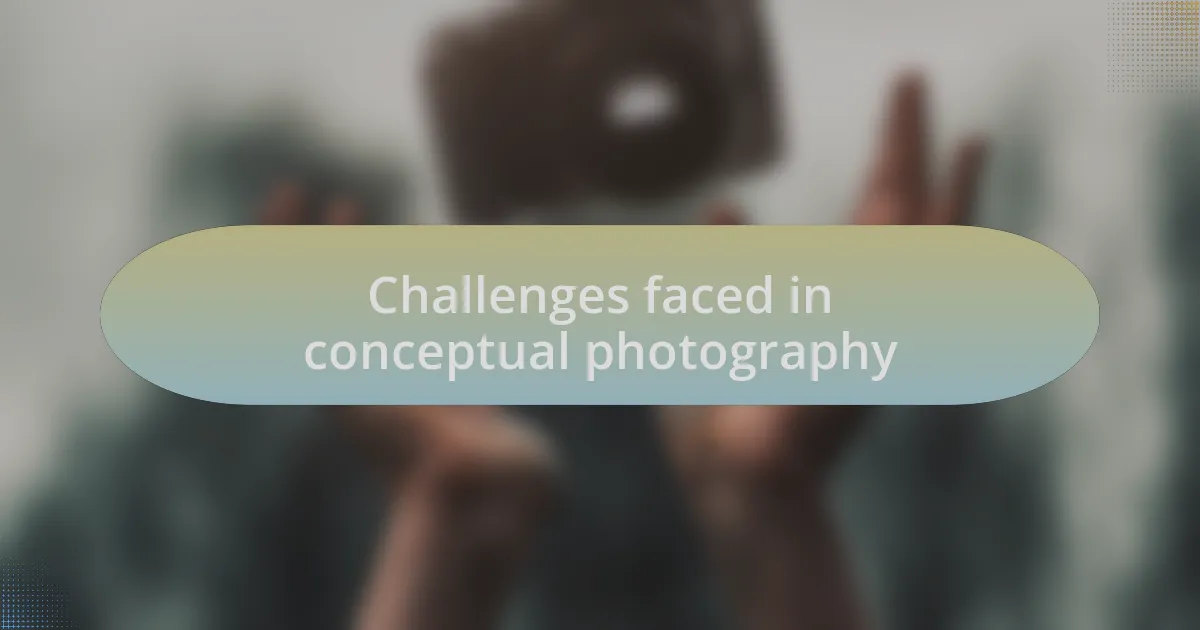
Challenges faced in conceptual photography
One of the biggest challenges I faced in conceptual photography was translating abstract ideas into visual form. I remember a project that focused on the concept of time. Determining how to visually represent something so intangible was daunting. I experimented with clocks and hourglasses, but none felt right. It forced me to dig deeper and rethink how fleeting moments could be captured—not just through objects but through emotional resonance.
Another struggle was communicating my vision to models or collaborators. During a particularly ambitious shoot about identity, I found it hard to articulate what I needed from the people involved. It’s frustrating when you envision something so clear in your mind but feel unable to share that vision effectively. Sometimes, the disconnect led to unexpected outcomes that, while challenging, transformed the final pieces in surprising ways. Have you ever felt misunderstood in your creative process?
The technical aspects of photography also brought hurdles. Finding the right lighting and props to reflect my concepts was often a trial and error process. I recall a shoot that required surreal shadows to symbolize internal conflict, but the natural light just wouldn’t cooperate. I battled with it for hours, only to realize later how much I’d learned about manipulating light and space in the process. Isn’t it fascinating how obstacles can enrich our understanding?

Lessons learned through my experience
During my journey in conceptual photography, I discovered the importance of patience. I once had a vision that seemed clear in my mind, but translating it to a shoot proved to be anything but straightforward. I found myself waiting for the right moment, the right light, and sometimes even the right mindset. It taught me that perfection is often a gradual process, not an immediate result. Have you experienced that feeling when you’re just waiting for everything to align?
Another lesson that resonated deeply with me was the power of collaboration. Initially, I thought I could realize my concepts entirely on my own. However, working with other creative minds brought fresh perspectives that enhanced my projects. I remember a particularly vibrant shoot when a team member introduced a new prop that completely transformed my initial idea. Their input not only improved the final outcome but also made the entire process more enjoyable. Have you ever collaborated and found that the synergy produced something even greater than you envisioned?
Lastly, I learned that embracing failure is a crucial part of growth. I once attempted to capture a concept that revolved around isolation, and the photos turned out disappointingly bland. Instead of being discouraged, I re-evaluated my approach and allowed myself the grace to experiment with different techniques. This led to a breakthrough in how I perceived isolation—not just as a visual state but as an emotional experience. Isn’t it remarkable how our missteps can lead us to profound understandings in our creative journey?